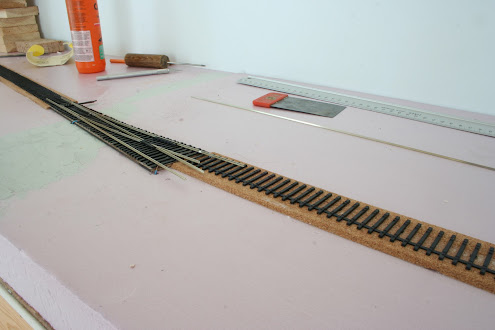To add some variation and visual interest I will let the passing mainline, which runs along the front of the layout, to slightly sloop to the left (railroad west), in a cut or on an embankment (depending on your point of view). Using a handsaw I removed part of the foam. Like this:
And the tracks will run downwards like this:
Of course, I will need some kind of retaining wall. I have not decided if it will be a stone, concrete or timber wall. Time will tell. I also have to figure out what to do where the track meets the backdrop, so it does not looks as if they end "wham" into a wall. I might widen the alyout a little at that end, and place some kind of structure there which the tracks can disappear under or through.
I have yet to order the rest of the turnouts, track tie strips and rail I need. When I sat down to calculate how much stuff I needed I also began to question whether I should use code 70 rail throughout or not. Why not try code 55 as well?
So I did a quick feasibility test. I removed the rails from a piece of weathered ME code 55 flex track I had lying around, and placed the rails on a piece of Central valley tie strip. The photos below shows my MP-15 DC with the front truck on the code 55 rail and the rear truck on some (non-weathered) code 70 rail. Click the pictures to get a better view.
I must admit that I get all excited by the looks of the engine on the slim code 55 rail. I will probably use it for some of the spurs, while I will stick to code 70 for the mainline, the yard tracks and the run-around track. And flange depth, which have long been an issue regarding N scale and code 40, does not seem to be an issue here.
















